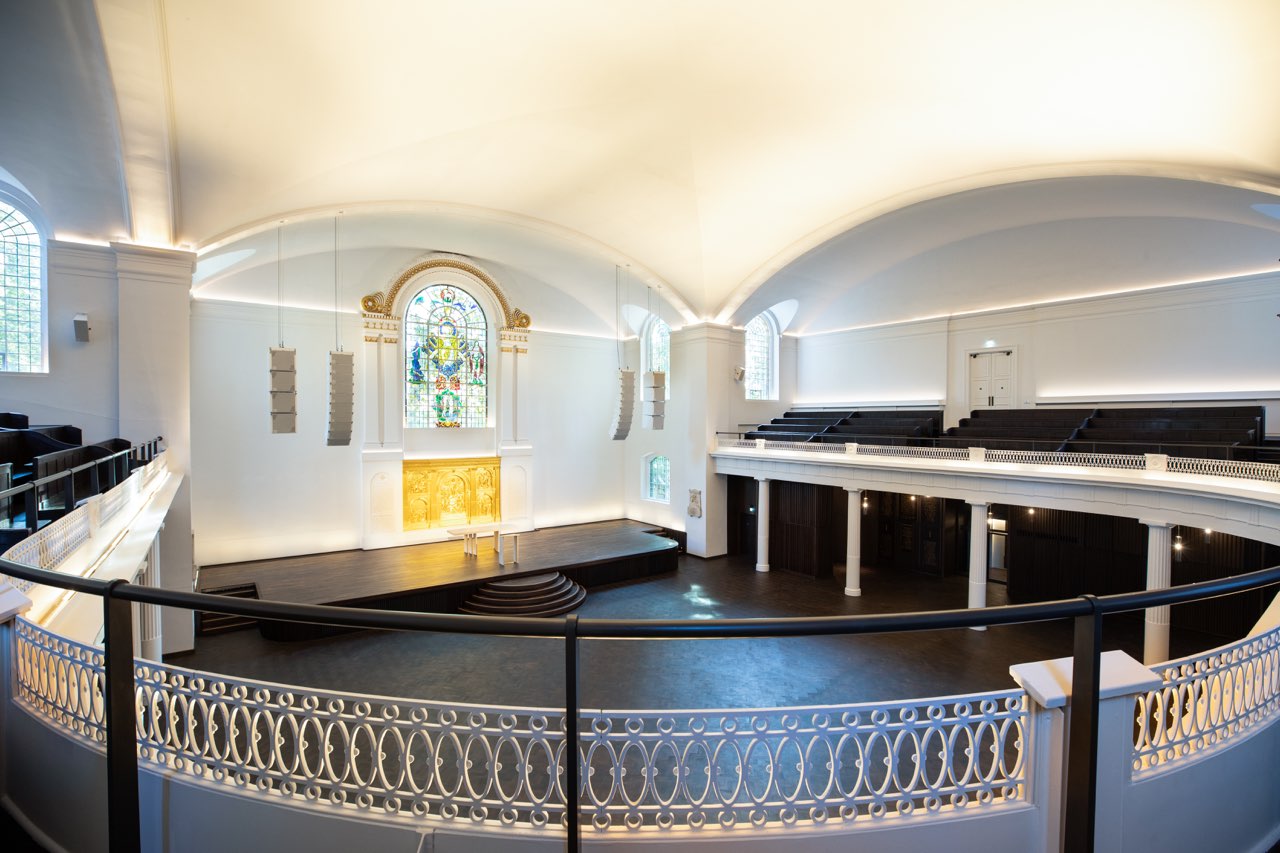Next-generation sound systems are well suited to emerging trends.
Has the past year seen the largest shift in worship practices in hundreds of years?
Perhaps that’s taking it too far. Setting aside the evolution in styles through contemporary worship and methods of communication, though, the “worship and word” combination has been a staple of services for a very long time. Just as the democratization of the gospel by translating it from Latin into local languages has brought the heart of the message closer to the people for whom it was intended, so, too, has the diversification of worship practices. Technological developments have been leveraged as methods of cultivating an incrementally more impactful worship experience. At the same time, advanced AVL’s capability and affordability have served to increase
its relevance for everyday use within a worship context.
Then, along came the novel coronavirus (COVID-19). Amid lockdowns, and with no in-person services taking place, it was up to churches to rethink how to engage with their congregation without any of the regular means of doing so. Sound systems were silenced, seats were emptied and congregations were forced to gather at a distance, without the joy of worshipping alongside those with whom they previously held fellowship.
Immediately, volunteers, staff, pastors and congregation families had to adjust to a new, content-led, analytics-heavy form of “doing church,” and it was entirely virtual. All the while, the pandemic continued to present a myriad of challenges. All houses of worship—from the local congregation first stepping into video, streaming and media management right through to those that had already been deep into broadcast (whether to satellite campuses or livestreaming)—now had to bridge the gap of engagement in a world in which screen fatigue was feeding disengagement and passivity. Those factors presented major challenges in terms of cultivating a digital version of fellowship.
Many tried to replicate their live Sunday format online and, quickly, they found that attendance was dropping. That’s perhaps not surprising, as digital audiences were engaging through platforms that are inherently distracting. The process of improvement, learning and stretching was a demanding one. Over time, we came to experience a digital renaissance of worship services, with teams finding their flow, new ideas flourishing and the creative engine of the church leveraging technology like never before. This “new normal” wasn’t to be forever, however; it incubated new strategies and church models in a phase of accelerated innovation never before seen in such a short time span.
One result was breaking the “Sunday silo” of the home church service. As people were keeping up with their own congregation, they could also visit churches from all across the world digitally with just a click—right from the comfort of their own living room (or wherever they use their mobile device).
It’s worth considering that things almost never move backwards. So, going back to live services likely won’t mean retreating from communicating through online platforms. Rather, our journey through COVID-19 will change the dynamic and increase the need for technology deployment across all platforms.
The sound system serving the live audience in an era of hybrid worship services now lives in an ecosystem with new demands, expectations and possibilities. That’s true whether we’re talking about a Sunday-ready, volunteer-friendly, portable sound system that provides a predictable level of performance while still being flexible to suit a variety of venues or whether we’re talking about a permanently installed sound system for one’s home sanctuary.

At one time, broadcast mixes were often reduced to the lowest common denominator (mobile-device speakers or headphones with variable levels of sonic-reproduction quality, for example); after the pandemic, though, the thirst for a heightened quality of in-person experience—free from distractions and with total authenticity—will be greater than before. The desire to immerse congregants completely in the experience of communal worship, instead of creating a worship-spectator window through the relatively distant method of absorbing content online, will no doubt continue to drive the demand for innovative sound-system solutions that will bring people closer together as they worship.
Here’s a question to consider in light of the past year’s events: How will we return to physical events, considering our dependence on technology to do anything? When we re-enter the rooms that host our physical services, will we have a different mindset? Will we have a fresh imagination of what could be possible? Will we have an attention to detail that will help take worship production value into the future?
From the manufacturer’s side, we’ve seen increased excitement, intrigue and movement on immersive technologies; a heightened desire for impeccable quality; greater attention to detail; and a non-negotiable standard of delivering an unforgettable experience for attendees. We see not only an opportunity to elevate the quality of sound systems to accurately transfer passions—this is our mission statement—but also a harvest from our investment into high-quality training, open
conversations and storytelling.
Particular brands experienced substantial growth in their house-of-worship business during 2020; that fact demonstrates an obvious positive attraction to investing in quality within the market. In addition, it signposts worship communities’ commitment to be on their best footing for a new era of services, whether they’re solely physical or hybrid. As someone who has served both on worship and on tech teams, this elevation of quality, I hope, will take us all closer to our worship mission statement: “To facilitate transparent, engaging and, ultimately, intimate worship experiences.”
Sound systems that behave well in terms of controlling energy within the desired coverage pattern will continue to be in higher demand as we emerge from the pandemic and welcome back the live congregation. Moreover, such systems allow for less spill onstage, and, in turn, present an easier route to an excellent broadcast mix. “More art, less noise,” as the saying goes!
We’re so often shown the costs of COVID-19—the sacrifices, the lives lost and the economic turmoil caused. But through all the trials with which this season has presented us, we’ve learned to think fresh, dare to be innovative and use technology to bring people closer to that which matters most.
The future of worship? It sounds good to me.
To read more from Sound & Communications, click here.
